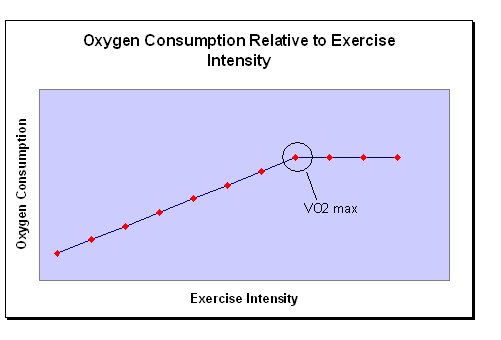VO2 max has been defined as:
"the highest rate of oxygen consumption attainable during maximal or exhaustive exercise" (3).
As exercise intensity increases so does oxygen consumption. However, a point is reached where exercise intensity can continue to increase without the associated rise in oxygen consumption. To understand this in more practical terms, take a look at the diagram below:

The point at which oxygen consumption plateaus defines the VO2 max or an individual's maximal aerobic capacity. It is generally considered the best indicator of cardiorespiratory endurance and aerobic fitness. However, as we’ll discuss in a moment, it is more useful as an indicator of a person's aerobic potential or upper limit than as a predictor of success in endurance events.
Aerobic power, aerobic capacity and maximal oxygen uptake are all terms used interchangeably with VO2 max.
VO2 max is usually expressed relative to bodyweight because oxygen and energy needs differ relative to size. It can also be expressed relative to body surface area and this may be a more accurate when comparing children and oxygen uptake between sexes.
 One study followed a group of 12-year-old boys through to the age of 20 - half of which were trained, the other half untrained but active. Relative to bodyweight no differences in VO2 max were found between the groups suggesting that training had no influence on maximal oxygen uptake. However, when VO2 max was expressed relative to body surface area, there was a significant difference between groups and maximal oxygen uptake did indeed increase in proportion to training
One study followed a group of 12-year-old boys through to the age of 20 - half of which were trained, the other half untrained but active. Relative to bodyweight no differences in VO2 max were found between the groups suggesting that training had no influence on maximal oxygen uptake. However, when VO2 max was expressed relative to body surface area, there was a significant difference between groups and maximal oxygen uptake did indeed increase in proportion to training

0 comments:
Post a Comment